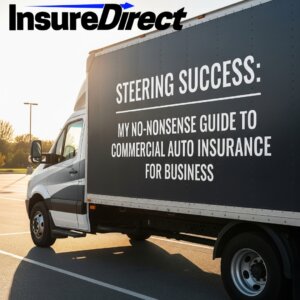Let me tell you—running a business with vehicles on the road? That’s not a “nice-to-have”; it’s your company’s circulatory system. Whether I’m sending out a technician across town or a semi across three states, those wheels turning means revenue flowing. But with motion comes risk—accidents don’t RSVP. One fender-bender could spiral into repair bills, lawsuits, downtime. You get the idea.
So, I learned early: commercial auto insurance ain’t optional. Personal policies? Those don’t cut it when the vehicle’s clocking miles on company time. Business wheels need business protection. Simple.
Why I Needed This Type of Coverage (And Why You Probably Do Too)
You might not think of it much, but when my employees started using their cars for deliveries, I realized we were wide open—legally and financially. Commercial auto insurance doesn’t just keep the DMV happy. It keeps the lights on after a wreck.
-
Keeps the Wallet from Weeping: Accidents aren’t cheap. Without proper coverage, I’d have been footing the bill for repairs, injuries, even lawsuits.
-
Covers Me When I’m Sued: If someone says I’m at fault? My policy’s there to step in—lawyers, settlements, the whole nine yards.
-
Fleet = Assets. Assets = Need Protection: My trucks and vans? That’s capital on wheels. If they get wrecked or stolen, insurance makes sure my operations don’t stall.
-
Employee Safety Matters Too: Coverage doesn’t stop with the vehicle. If one of my guys gets hurt while driving on the job, medical coverage helps patch things up (hopefully quick).
-
Keeps Business from Screeching to a Halt: Things happen. But when I’m insured? We bounce back faster, no question.
What My Policy Actually Covers (It’s More Than I Thought)
Truth be told, I didn’t know how many options were on the table until I sat down with my agent. Some things felt obvious. Others? Total eye-openers.
-
Bodily Injury Liability pays if we’re responsible and someone gets hurt. Simple, but critical.
-
Property Damage Liability kicks in when my van clips someone’s mailbox (or… garage door—yeah, that happened once).
-
Collision Coverage? That one saved my bacon after a snowstorm wrecked my service truck.
-
Comprehensive Coverage handles the weird stuff. Vandalism, hail, even if someone swipes a mirror while it’s parked overnight.
-
Medical Payments / PIP is like a first-aid fund. It handles hospital bills, whether it’s my driver’s fault or not.
-
Uninsured/Underinsured Motorist Coverage? A godsend when that guy with no insurance rear-ended my delivery car.
-
Hired & Non-Owned Auto was one I almost missed. If an employee uses their own car for business and crashes it? That’s on me—unless I’ve got this.
-
Rental Reimbursement means I don’t lose a workday while waiting for repairs.
-
Roadside Help? Worth every penny. Dead battery on a job site? Tow truck’s en route.
What Impacts the Price Tag?
Cost? Let’s just say it depends. And when I first got quotes, I didn’t understand why there was such a spread.
-
Vehicle Size & Type: Bigger rigs, higher price. Makes sense. Repairing a refrigerated truck costs way more than a compact van.
-
Usage Patterns: My fleet’s on the road all day, every day. The more you drive, the more you pay—risk multiplies.
-
Employee Driving Records: This one stung. One speeding ticket can mess with my whole premium.
-
Where I Operate: Downtown has more traffic (and more accidents) than my warehouse district. City zip codes cost more.
-
Deductibles vs. Limits: Higher deductibles = lower premiums, but also more out-of-pocket when bad luck strikes.
-
Past Claims: A couple of fender benders last year nudged my rate up. Insurance companies don’t forget.
-
Safety Tech: I added dash cams and GPS tracking. Some insurers liked that. Gave me a little break.
How I Picked the Right Policy (Trial, Error, and Advice)
If I’d just grabbed the first quote I got? I’d be underinsured and overpaying. Took some digging.
-
Figured Out My Needs: I listed out every vehicle, what it does, and who drives it. Delivery, transport, service calls—it all mattered.
-
Checked Legal Requirements: My state’s rules were just the floor. I went higher—because a lawsuit could bury me.
-
Shopped Around: I got five quotes. No joke. They ranged wildly. Read the fine print, not just the price.
-
Asked Around About Insurers: Called other business owners. Read some reviews. Some companies talk a big game but fumble claims.
-
Looked for Bundles: Bundling with liability coverage shaved a few hundred bucks off.
-
Found a Good Agent: Honestly? She was the real MVP. Explained things in plain English. Found gaps I missed.
What I Did After an Accident (And You Should Too)
When my delivery van got T-boned last winter, I didn’t panic. I had a plan. Followed it.
-
Checked on Everyone: Safety first. Driver called me before 911. That’s not how it should go.
-
Called the Cops: Needed that report—it’s like gold during claims.
-
Took Photos: Every angle. Damage, street signs, everything.
-
Got Witness Info: People saw it happen. I made sure to grab their names.
-
Notified My Insurance Company Immediately: The sooner, the better.
-
Filled Out Everything: Claim forms, repair estimates—I got it all done that day.
-
Stayed in Touch With the Adjuster: They asked for receipts and I delivered.
-
Reviewed the Settlement: It was fair. I didn’t argue. But if it wasn’t? I’d have pushed back.
Let’s wrap this up: If you’re rolling vehicles for business and don’t have commercial auto insurance dialed in, you’re playing with fire. The roads are unpredictable. Accidents cost real money. But with the right policy? You’re covered, you’re calm, and you keep on truckin’. Literally.


